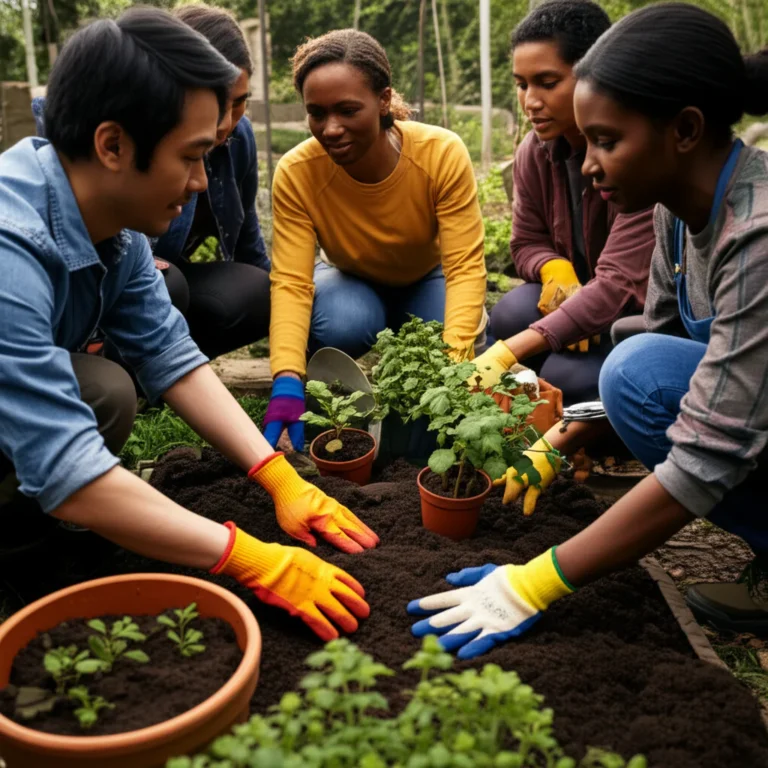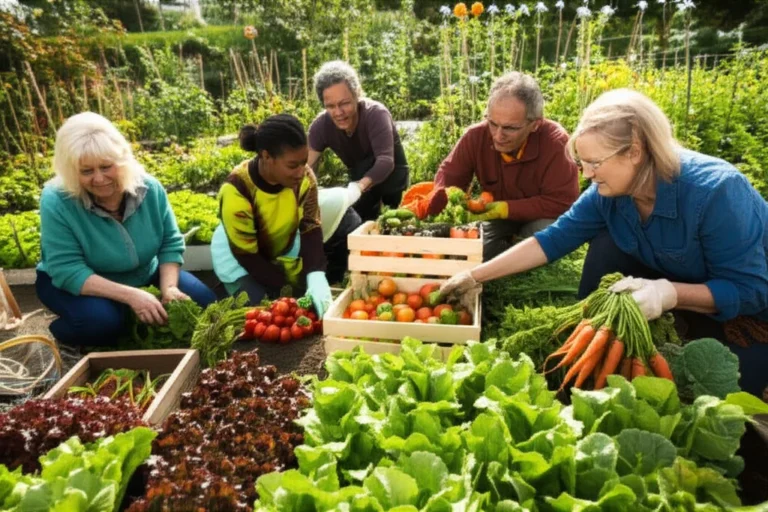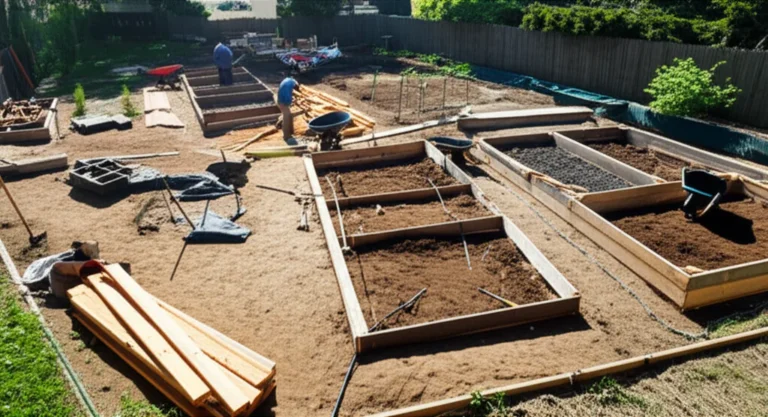Support our educational content for free when you purchase through links on our site. Learn more
Imagine a once-neglected urban lot transformed into a vibrant oasis where neighbors not only grow fresh veggies but also forge lasting friendships, break down social barriers, and build a stronger, more connected community. That’s the magic of community gardens! But how exactly do these green spaces promote social cohesion, and why are they becoming essential hubs in cities worldwide?
In this article, we’ll uncover 12 powerful ways community gardens cultivate social bonds—from fostering shared purpose and intergenerational exchange to reducing crime and empowering local leaders. Whether you’re a seasoned gardener or a curious community member, you’ll discover how these leafy patches do far more than just feed bodies—they nourish minds and neighborhoods alike. Plus, we’ll share insider tips from the Community Gardening™ team and real stories that prove the transformative power of growing together.
Ready to dig into the roots of social cohesion? Let’s get started!
Key Takeaways
- Community gardens create shared goals and spaces that bring diverse people together, fostering trust and cooperation.
- They break down social barriers by promoting inclusivity and informal interactions among neighbors of all ages and backgrounds.
- Gardens serve as platforms for skill-sharing, intergenerational mentorship, and local leadership development.
- Participation in community gardening is linked to improved mental health, neighborhood safety, and stronger civic engagement.
- Overcoming challenges like conflicts and exclusion requires clear policies and inclusive governance.
- For those looking to start or enhance a garden, investing in quality tools from brands like Fiskars and Corona can make all the difference.
👉 Shop gardening essentials:
- Fiskars Garden Tools on Amazon | Walmart | Fiskars Official Website
- Corona Hand Pruners on Amazon | Walmart | Corona Official Website
Dive deeper with Community Gardening™ and watch your neighborhood—and your friendships—flourish!
Table of Contents
- ⚡️ Quick Tips and Facts
- The Roots of Connection: A Brief History of Community Gardening & Social Bonds
- What Exactly is Social Cohesion, Anyway? 🌱
- The Magic Ingredients: How Community Gardens Brew Social Cohesion
- Cultivating Shared Purpose: Working Together for a Common Goal
- Breaking Down Barriers: Fostering Inclusivity and Diversity
- Sprouting Conversations: The Power of Informal Interactions
- Harvesting Skills: Learning, Sharing, and Mentorship
- Nourishing Minds and Bodies: Mental Well-being, Health, and Connection
- Growing Local Leaders: Empowering Community Governance
- Bridging Generations: Intergenerational Exchange and Wisdom Sharing
- Feasting Together: Community Meals and Celebrations
- Green Spaces, Safer Places: Reducing Crime and Enhancing Neighborhood Security
- Economic Seeds: Local Food Systems and Skill-Sharing Benefits
- Environmental Stewards: Collective Action for a Greener Planet
- A Sense of Belonging: Creating a Home Away From Home
- Beyond the Plot: Ripple Effects of Garden-Grown Cohesion
- Challenges in the Compost Pile: Overcoming Obstacles to Social Cohesion
- Sowing the Seeds of Success: Best Practices for Maximizing Social Cohesion
- Measuring the Bloom: How Do We Know It’s Working?
- Our Own Patch: Anecdotes from the Community Gardening™ Team
- Conclusion: The Unfolding Blossom of Community
- Recommended Links
- FAQ
- Reference Links
⚡️ Quick Tips and Facts
Welcome to the green heart of social cohesion! 🌿 Here’s a quick snapshot from the Community Gardening™ team on how community gardens are secret social superchargers:
- Community gardens boost social cohesion by creating shared spaces where neighbors meet, chat, and collaborate.
- They reduce social isolation and foster a sense of belonging, especially in urban areas.
- Gardens encourage diversity and inclusivity, welcoming people of all ages, backgrounds, and abilities.
- Participation in gardening activities can improve mental health by reducing stress and increasing happiness.
- Community gardens often lead to local leadership and empowerment, giving residents a voice in their neighborhood.
- These green spaces can lower crime rates by increasing neighborhood watchfulness and pride.
- Social cohesion from gardens is linked to better physical health outcomes through increased activity and healthier eating.
Want the full scoop? Stick with us as we dig deeper into the roots of how community gardens cultivate social bonds that bloom far beyond the soil! 🌸
For more on the broader benefits, check out our article on community garden benefits to the global community.
The Roots of Connection: A Brief History of Community Gardening & Social Bonds
Community gardening isn’t just a modern trend—it’s a centuries-old tradition that has long served as a social glue. From the victory gardens of World War II to urban allotments in Europe, people have gathered to grow food and friendships alike.
Why history matters: Understanding the evolution of community gardens helps us appreciate their role as hubs of social cohesion today. These gardens have historically been places where diverse groups come together, share resources, and build trust.
Fun fact: During the Great Depression, community gardens helped neighborhoods survive economic hardship while fostering solidarity. Today, they continue to do the same, especially in rapidly changing urban areas facing gentrification.
For a fascinating dive into the historical context, see this thesis on community gardens and social cohesion.
What Exactly is Social Cohesion, Anyway? 🌱
Before we get our hands dirty, let’s clarify what social cohesion means. At its core, social cohesion is the strength of relationships and the sense of solidarity among members of a community. It’s about trust, belonging, and mutual support.
Key components include:
- Social networks: Connections between neighbors and community members.
- Sense of belonging: Feeling “at home” in your community.
- Shared values and norms: Common goals and respect for one another.
- Social participation: Active involvement in community activities.
Community gardens are fertile ground for all these components—they literally grow social cohesion by bringing people together around a shared purpose.
For more on social cohesion’s role in health and community, check out our Benefits of Community Gardens category.
The Magic Ingredients: How Community Gardens Brew Social Cohesion
Community gardens are like social alchemists, transforming soil, seeds, and sweat into bonds that hold neighborhoods together. Let’s break down the 12 key ways they promote social cohesion, backed by research and our own green-thumbed experience.
1. Cultivating Shared Purpose: Working Together for a Common Goal
Nothing unites like a shared mission! Community gardens give people a common goal—growing food and beautifying their neighborhood. This shared purpose fosters cooperation and teamwork.
- Why it works: When people work side-by-side, they build trust and learn to rely on each other.
- Our experience: At Community Gardening™, we’ve seen how group planting days spark friendships that last beyond the garden fence.
2. Breaking Down Barriers: Fostering Inclusivity and Diversity
Community gardens are melting pots of culture, age, and socioeconomic backgrounds. They break down social barriers by encouraging interaction among diverse groups.
- Studies show gardens in gentrifying neighborhoods help bridge gaps between longtime residents and newcomers.
- Gardens welcome everyone—kids, seniors, immigrants, and people with disabilities—creating a truly inclusive space.
3. Sprouting Conversations: The Power of Informal Interactions
Sometimes, the best connections happen over a casual chat while watering plants or harvesting tomatoes.
- These informal social interactions build familiarity and reduce social isolation.
- Urban parks and gardens provide safe, comfortable spaces for spontaneous conversations.
4. Harvesting Skills: Learning, Sharing, and Mentorship
Gardening is a great teacher, and community gardens are classrooms for skill-sharing.
- Experienced gardeners mentor newbies, creating bonds through knowledge exchange.
- This skill-sharing extends beyond gardening—people often swap recipes, crafts, and life stories.
5. Nourishing Minds and Bodies: Mental Well-being, Health, and Connection
Community gardening isn’t just good for your body—it’s a balm for the soul.
- Studies link gardening to reduced stress, improved mood, and lower rates of depression.
- The social support from garden friends enhances mental health and resilience.
6. Growing Local Leaders: Empowering Community Governance
Gardens often require organization—committees, rules, and events—which cultivates local leadership.
- Participants gain confidence and a voice in neighborhood affairs.
- This empowerment strengthens community ties and civic engagement.
7. Bridging Generations: Intergenerational Exchange and Wisdom Sharing
Community gardens are intergenerational playgrounds where young and old share stories, skills, and laughter.
- Older gardeners pass down traditional knowledge, while younger members bring fresh ideas.
- This exchange fosters respect and understanding across age groups.
8. Feasting Together: Community Meals and Celebrations
Nothing says community like sharing food! Many gardens host potlucks, harvest festivals, and cooking classes.
- These events deepen social bonds and celebrate cultural diversity.
- They also highlight the fruits of collective labor—literally!
9. Green Spaces, Safer Places: Reducing Crime and Enhancing Neighborhood Security
Gardens can transform neglected lots into vibrant, watched-over spaces.
- Research links well-maintained green spaces to lower crime rates and increased perceptions of safety.
- Community presence deters vandalism and fosters neighborhood pride.
10. Economic Seeds: Local Food Systems and Skill-Sharing Benefits
Community gardens contribute to local economies by:
- Providing affordable fresh produce.
- Offering opportunities for skill-building that can lead to jobs or small businesses.
11. Environmental Stewards: Collective Action for a Greener Planet
Gardens unite people around environmental care, fostering a shared responsibility for urban nature.
- This collective stewardship strengthens community identity and cohesion.
12. A Sense of Belonging: Creating a Home Away From Home
Ultimately, community gardens create places where people feel they belong—a vital ingredient for social cohesion.
- This sense of belonging combats loneliness and builds resilient communities.
For more on garden design that fosters these social benefits, explore our Garden Design Ideas section.
Beyond the Plot: Ripple Effects of Garden-Grown Cohesion
The social cohesion seeded in community gardens doesn’t stay put—it spreads through neighborhoods and cities.
- Improved neighborhood attachment: People feel more connected to their area, leading to increased civic participation.
- Healthier communities: Social support networks encourage healthier behaviors and better mental health.
- Stronger social capital: Trust and cooperation extend beyond the garden gates to schools, local businesses, and public spaces.
Studies like those summarized in the PMC article show that urban green spaces, including gardens, are vital for fostering these positive community-wide outcomes.
Challenges in the Compost Pile: Overcoming Obstacles to Social Cohesion
Of course, not all is sunshine and roses. Community gardens face hurdles that can hinder social cohesion:
- Conflict over garden rules or plot allocation.
- Exclusion of marginalized groups if not actively addressed.
- Maintenance challenges leading to neglected spaces and reduced participation.
- Gentrification pressures that may displace longtime gardeners.
Our advice? Establish clear, inclusive policies and open communication channels. Check out our Community Garden Policies for tips on navigating these issues.
Sowing the Seeds of Success: Best Practices for Maximizing Social Cohesion
Want your garden to be a social powerhouse? Here’s what we recommend:
- Host regular community events like workdays, potlucks, and workshops.
- Create inclusive governance structures that give everyone a voice.
- Design spaces that encourage interaction—benches, communal plots, and shaded areas.
- Promote diversity by reaching out to underrepresented groups.
- Partner with local organizations to expand resources and support.
These strategies are backed by research and our own hands-in-the-dirt experience at Community Gardening™.
Measuring the Bloom: How Do We Know It’s Working?
Measuring social cohesion can feel like trying to catch sunlight in a jar, but there are ways:
- Surveys and interviews assessing trust, belonging, and social networks.
- Observation of participation rates and diversity in garden activities.
- Tracking community outcomes like crime rates, health indicators, and civic engagement.
Research such as the systematic review in PMC9229094 highlights the importance of combining quantitative and qualitative methods to capture the full picture.
Our Own Patch: Anecdotes from the Community Gardening™ Team
We can talk stats all day, but here’s a little story from our own garden:
Last summer, a shy newcomer named Maria joined our garden. At first, she kept to herself, tending her plot quietly. But over weeks, as she shared tomatoes and gardening tips, she blossomed socially. Now, Maria organizes our monthly potlucks and has become a beloved community leader. 🌻
Stories like Maria’s remind us that community gardens are more than just green spaces—they’re places where people grow roots, friendships, and hope.
Conclusion: The Unfolding Blossom of Community
So, what have we learned on this verdant journey? Community gardens are much more than just patches of green—they are powerful catalysts for social cohesion. They nurture shared purpose, break down barriers, and cultivate friendships that flourish beyond the garden fence. From boosting mental well-being to empowering local leaders, these spaces are social superstars in urban landscapes.
While challenges like conflicts or gentrification pressures exist, they’re far from insurmountable with thoughtful policies and inclusive practices. Our own stories, backed by robust research, show that the magic of community gardens lies in their ability to create a true sense of belonging and collective empowerment.
If you’ve been wondering whether investing time or resources in a community garden is worth it, we say a resounding YES! The social, health, and environmental returns are rich and rewarding.
Ready to get your hands dirty and your community thriving? Let’s grow together! 🌿
Recommended Links
Looking to equip your community garden or deepen your knowledge? Here are some top picks:
-
Gardening Tools & Supplies:
-
Books on Community Gardening & Social Cohesion:
-
Seeds and Edible Plants:
Explore more gardening inspiration at our Garden Design Ideas and Edible Plants categories.
FAQ
What role do community gardens play in fostering a sense of community among residents?
Community gardens act as social hubs where residents gather, collaborate, and share experiences. By working towards a common goal—growing food and beautifying their neighborhood—they create strong social networks and a sense of belonging. These gardens encourage regular interaction, which builds trust and mutual support, essential ingredients for a cohesive community. Research shows that people involved in community gardening report higher neighborhood attachment and social cohesion, which translates into improved well-being and civic engagement.
How can community gardens be used to promote intergenerational relationships and social connections?
Community gardens naturally bring together people of all ages. Older gardeners often share traditional knowledge and gardening wisdom, while younger participants bring energy and new ideas. This intergenerational exchange fosters respect, learning, and social bonds across age groups. Activities like mentoring, shared workdays, and community events create opportunities for meaningful interaction, reducing generational divides and promoting social cohesion.
In what ways do community gardens help to break down social barriers and promote inclusivity?
Community gardens are inclusive spaces welcoming people regardless of race, ethnicity, age, or socioeconomic status. They provide a neutral ground where diverse groups can meet and collaborate, helping to break down prejudices and stereotypes. Gardens often host multicultural events and encourage participation from marginalized groups, fostering understanding and respect. This inclusivity strengthens social cohesion by building a community that values diversity and shared purpose.
Can community gardens serve as a catalyst for community engagement and social change in urban areas?
Absolutely! Community gardens empower residents to take an active role in their neighborhoods. By organizing governance structures, events, and maintenance, gardeners develop leadership skills and a voice in local affairs. Gardens also improve neighborhood aesthetics and safety, which can inspire broader community revitalization efforts. In gentrifying areas, gardens help maintain social cohesion by fostering connections between longtime residents and newcomers, acting as anchors of stability and social capital.
How do community gardens impact mental and physical health through social cohesion?
The social connections formed in community gardens provide emotional support and reduce feelings of loneliness, which are crucial for mental health. Gardening itself is a physical activity that promotes fitness, but the added social engagement amplifies benefits by reducing stress and improving mood. Studies link garden participation to lower rates of depression and anxiety, highlighting the powerful synergy between social cohesion and health.
Reference Links
- Community gardens and their effects on diet, health, psychosocial and community outcomes: A systematic review
- Urban green spaces and social cohesion: A systematic review
- Community gardens as a tool for social cohesion in gentrifying neighborhoods
- Fiskars Official Website
- Corona Tools Official Website
- Burpee Seeds Official Website
- Johnny’s Selected Seeds Official Website
For more insights and resources, visit our Community Gardening™ homepage.





